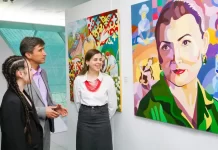Felt making is one of Iran’s oldest handicrafts, deeply rooted in the country’s cultural traditions and particularly flourishing in regions of Khorasan Razavi province such as Neyshabur, Bardaskan, Kalat, and tribal areas. This centuries-old craft, produced with wool, has historically provided people with rugs, clothing, bedding, and decorative items—serving both practical and artistic purposes.
Archaeological and historical evidence shows that felt was widely used in ancient societies, especially in cold and mountainous climates. Nomadic communities relied on its thermal and moisture-wicking qualities for making tents, blankets, and garments. Its natural fire resistance and insulating properties made it indispensable across diverse climates.
“Felt making is more than just a craft; it is a cultural and historical identity that must be preserved and passed to future generations,” said Azam Naseri, a handicrafts expert.
Naseri emphasized that felt making symbolizes Iranian art and culture, representing values of resilience, creativity, and tradition. She noted that the process involves intertwining sheep wool fibers with soap and egg yolk under moisture and pressure—an intricate method requiring precision, skill, and generations of experience.
Despite its cultural importance, the art of felt making faces serious challenges today. A declining number of artisans, lifestyle changes, and reduced demand—partly due to modern decorations and the strong natural scent of wool—have led to decreased production. Younger generations are less inclined to learn the craft, threatening its continuity.
To counter this decline, Naseri suggested increased promotion through workshops, exhibitions, and training programs, especially targeting youth. She also highlighted the significant role of women in felt making, many of whom sustain their livelihoods through this art. Supporting women artisans, she said, can foster economic empowerment and social recognition.
Naseri further underlined the export potential of felt products: “With their beauty, quality, and cultural value, Iranian felt works can secure a strong position in international markets. Promoting this art globally not only supports income generation but also introduces the richness of Iranian culture to the world.”
As Iran faces the pressures of modernization and industrial materials, felt making remains a symbol of heritage, artistry, and resilience. Preserving this ancient craft ensures that its unique cultural and artistic legacy continues to inspire future generations both at home and abroad.
BY: The Times Union







